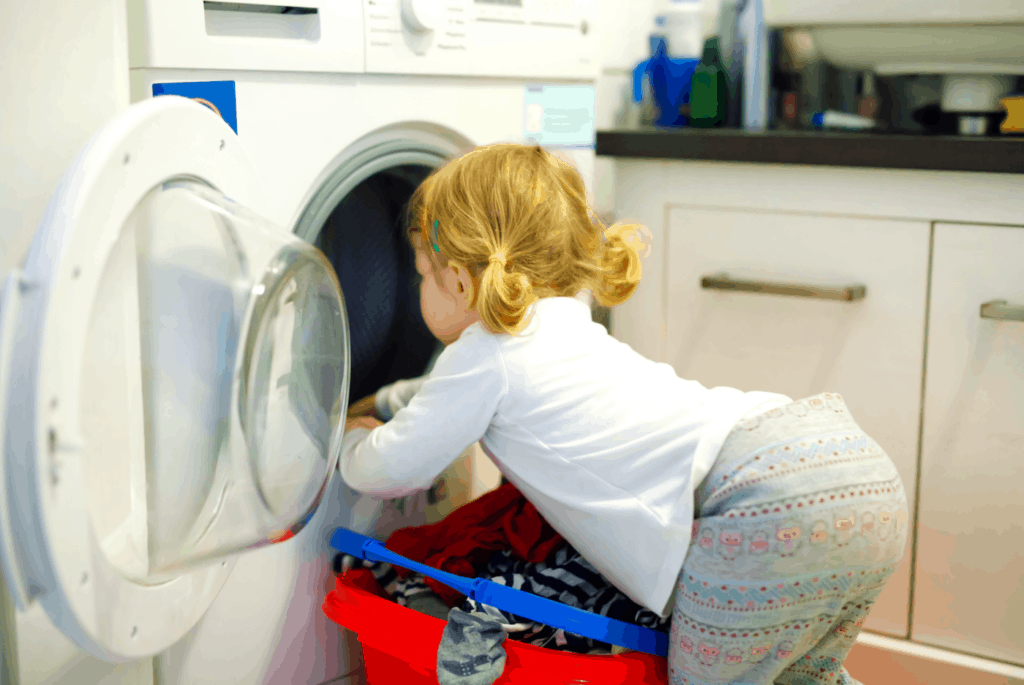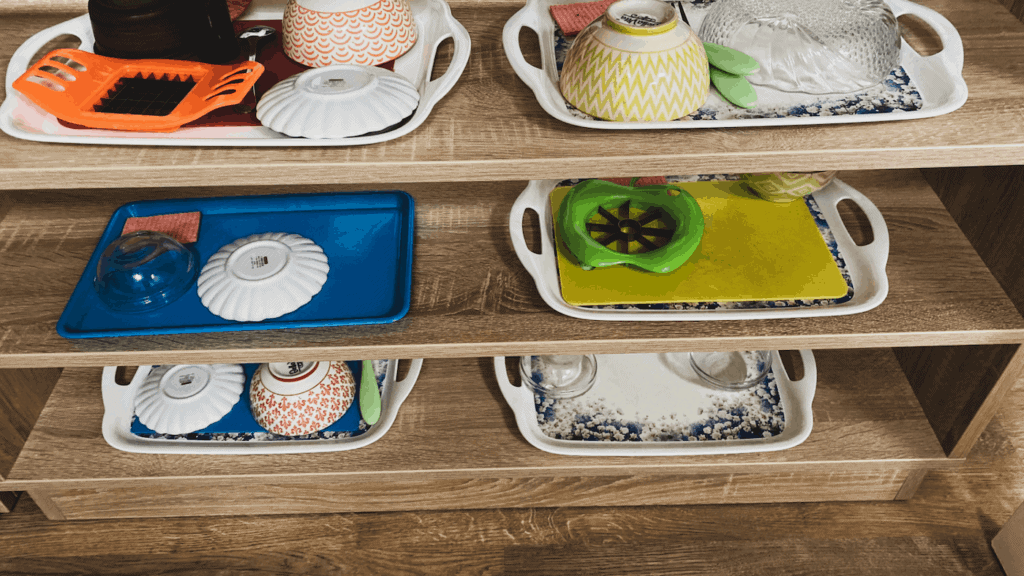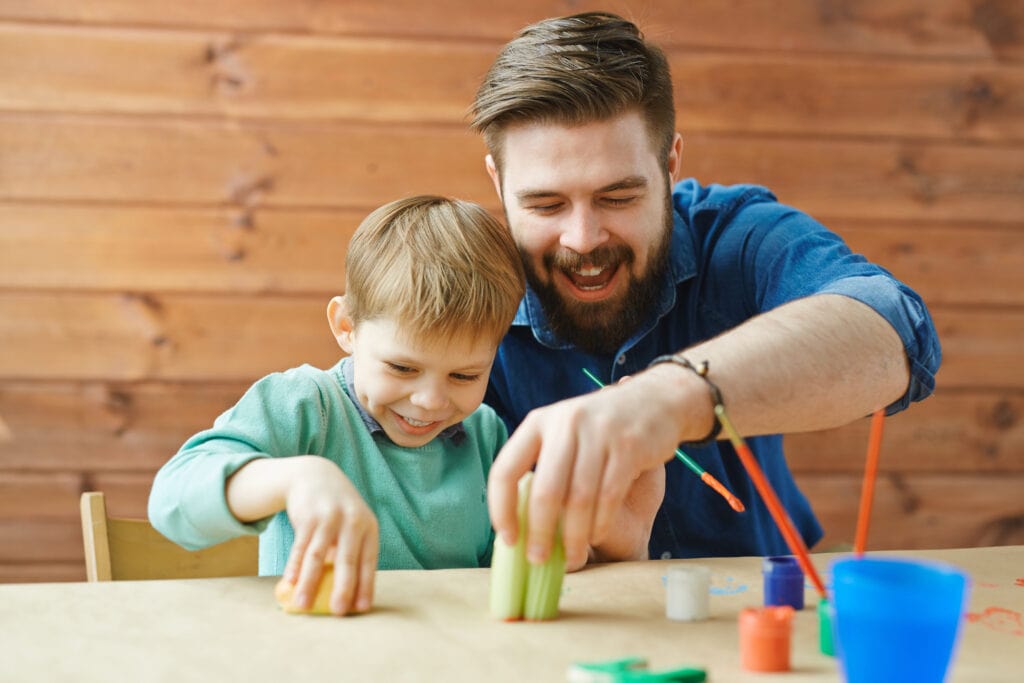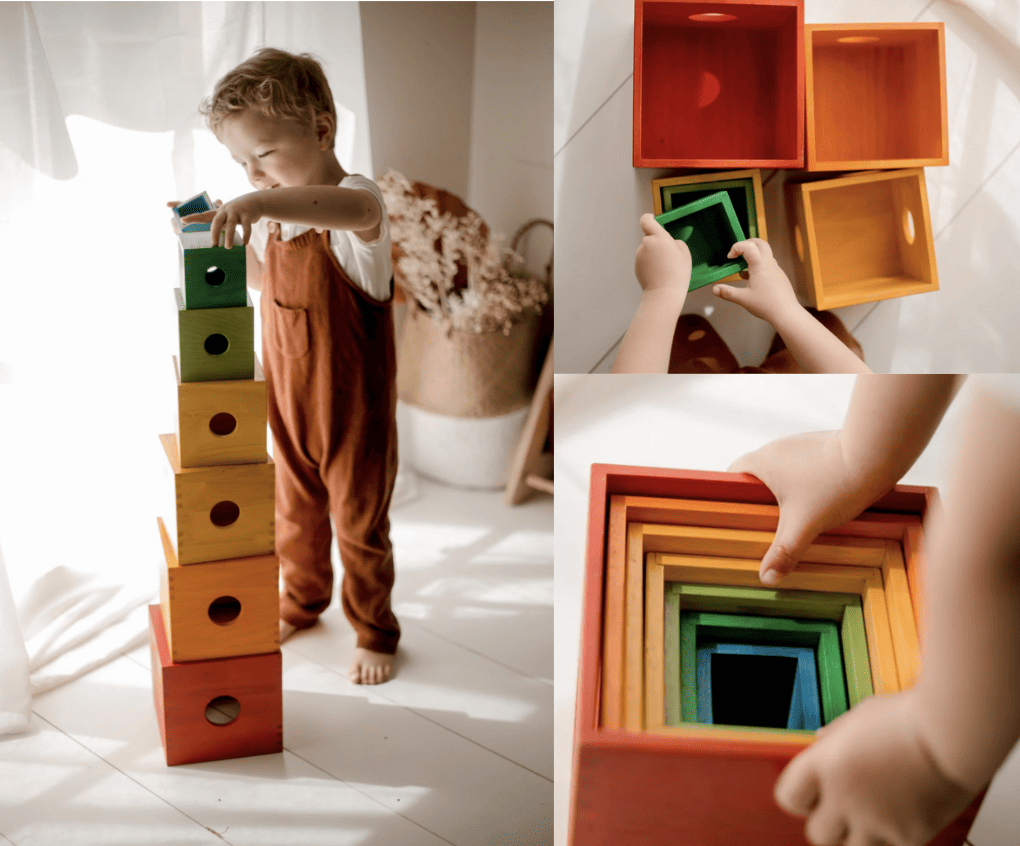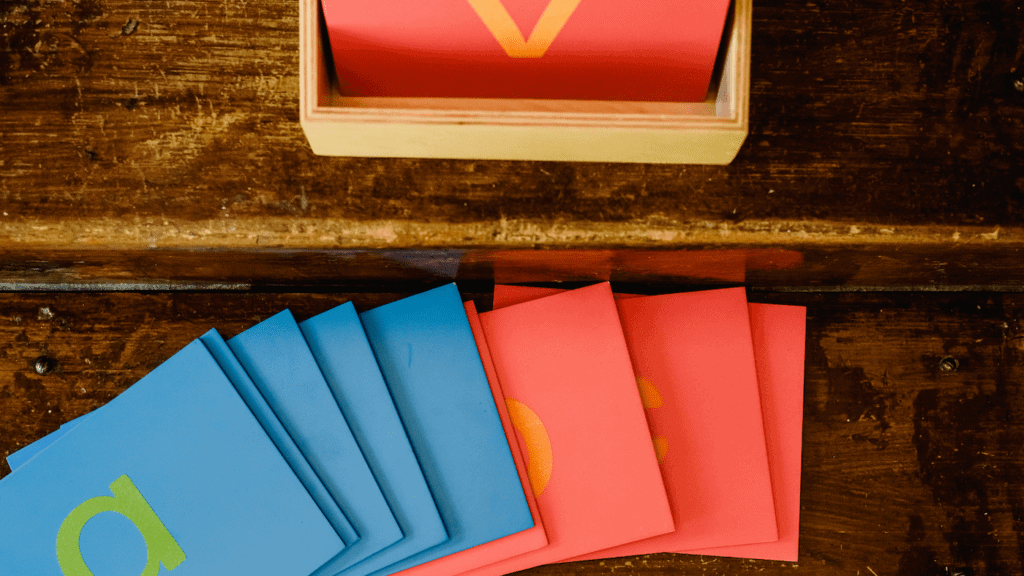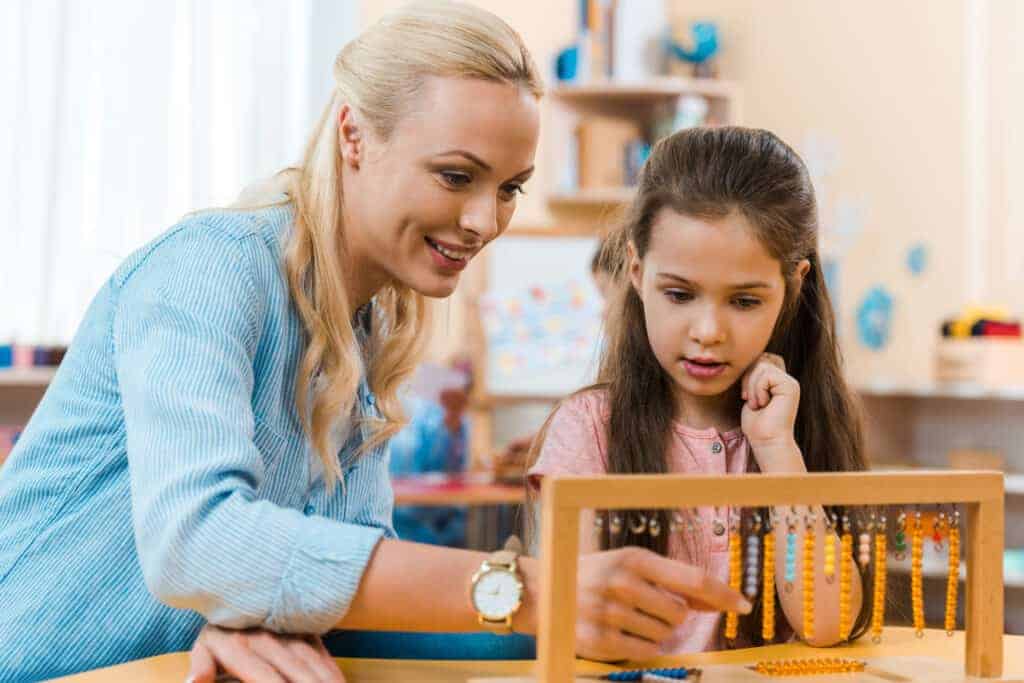I learned about
Montessori specific methods for reading focus heavily on sound and sensory experience before introducing the child to phonics and the alphabet. With a vocabulary knowledge rooted in sound, a child can easily associate written letters with the sounds they already know. This is called encoding or reading.
While this may seem straightforward, the key to having your child reading by 4 years old lies in the work you put in when they’re babies. Below I dive into what makes the
On This Page…
- Children Start Absorbing Language Right Away
- Allow Your Newborn to Be Part of Your Family
- They Start Learning to Communicate.
- Use This Communication to Build Vocabulary
- Not with A Fizzle, But With A “Language Explosion”
- Now for Phonics: The Reason You’re Here
- Most Children End Up Reading By 4
- Apply These Methods in Your Home
- No One Is Too Old for Montessori
Children Start Absorbing Language Right Away
Maria Montessori promotes the idea that children have absorbent minds. It’s why she wrote a book called The Absorbent Mind.
The Daily Montessori writes:
“Montessori observed how children learned the language without anyone teaching them.”
Imagine that, you don’t even have to teach your child English! That’s what
This environment creates a fertile mind and plants the seeds for phonics and reading comprehension to thrive.
| Age | Child’s Language Development | Montessori Dos | Montessori Don’ts |
| 0-6 Months | Observing surroundings Hearing family sounds and noises | Allow the child to be part of the family | Leave the child alone in a room while he/she is awake |
| 6-12 Months | Starting to talk back Experimenting with vocalization | Talk to the child as if you were talking to another adult | Use high pitched baby speak |
| 1-2 Years | Learning to communicate Starting to pick up phonics | Use books, singing, rhymes to build vocabulary | Talk at the child, rather, talk to them |
| 2-3 Years | Sentence formation Rapid vocabulary expansion | Use picture books with 1-2 descriptive sentences per page Use phonetic sound cards | Correct them when they misarticulate words |
| 3-6 Years | Pre-reading Pre-writing Learning complete alphabet and phonetics Formal reading/writing instruction begins | Use tangible alphabet letters and toys Allow the child to read/write in groups | Give them books about topics that don’t interest them |
Sources (dailymontessori.com and applemontessorischools.com)
Allow Your Newborn to Be Part of Your Family
Remember,
So, the call to allow them to be part of the family simply means keeping them in the same room as you while you go about your daily business or chores.
This freedom the child has within the four corners of the blanket gives them a sense of independence. In this state, they are comfortable and safe to absorb all the sights and sounds of life in your household.
At the age of 0-6 months, the information observed is raw and uncurated. Your child isn’t learning what sound the letter B makes. Rather, they are just hearing you speak to:
- Them
- Yourself
- Your spouse
- Your other kids
- Your pet
Along with absorbing the sounds of the words you use; your child is also absorbing the tone of your voice.
At this age, there is not much comprehension happening, but there is a lot of raw information being processed and stored away.
They Start Learning to Communicate.
At 6-12 months, a child is able to start using all that raw data they’ve absorbed to communicate with you. Now, I said to start communicating, they aren’t going to be reading just yet.
According to thedailymontessori.com, a good model is:
- The adult talks then pauses
- Allow for silence
- The child talks (babbles)
- Allow for silence
- Repeat
There is an awesome, and adorable example of this on YouTube.
Notice how the father isn’t using baby speak or a reduced vocabulary, he’s talking to his son as if he’s another adult. Just as if he’s talking to another adult, he’s:
- Making eye-contact
- Smiling
- Listening (even though the kid’s noises are nonsensical)
- And responding
He’s also describing what he’s seeing, especially when his son points to something. This shows his son that they are talking about their environment, from which he has already been constantly absorbing information.
Use This Communication to Build Vocabulary
During your child’s second year, the communication skills you’ve been modeling will start them down another round of absorption.
Remember, your kid is always absorbing. They don’t just reach 12 months, learn to communicate, and stop absorbing information so they can move on to the next thing. The difference here is that they have a new tool: communication.
With this new tool, they can start sorting and organizing all of the raw information that they’ve absorbed just from being in your household.
Enter: Vocabulary.
At this age, it’s important to resist talking to your child using baby speak. They absorb your tone, and it can be confusing for a child to turn 2 or 3 and have an adult suddenly start speaking to them differently. I remember being terrified the first time I heard a man outside my family speak to me normally.
They won’t instantly be repeating words you use with them either, but they will be absorbing vocabulary. Remember to let them do this at their own pace. This part is hard, especially when you hear other parents telling you how proud they are of their kid’s reading level.
The key to remember here is that prolonged and persistent effort putting these methods into practice will lead to the eventual language explosion, even if it doesn’t seem fruitful at first.
A newborn absorbs raw information like the sights, sounds, and smells associated with pots and pans in the kitchen. But now equipped with the tool of communication, you can help your one-year-old associate that raw information with a vocabulary word.
Daily Montessori provides many ways to go about this:
- Use books, singing, and rhymes. Talk to them slowly and clearly, but not in baby speak
- Try not to over anticipate their needs, just allow them to absorb at their own pace
- Give your child a reason to communicate, usually starting with their needs
- Do not always respond to your kid. You are a human with your own need for space, not an on-demand dictionary
- Name the item they want before giving it to them. This could also be an opportunity to implement a quick “3-period lesson.”
Communicating with your child using the methods
Not with A Fizzle, But With A “Language Explosion”
After a couple years of putting in all the work, here’s the first big payoff… as if having a kid in the first place isn’t the biggest payoff of your life already.
You’ve done it all.
- Created a family environment geared towards the absorbent mind. Allowed your infant to be a part of it.
- You talked to the kid normally, and resisted the use of baby speak even in the face of daily cuteness overload.
- You’ve sung songs, had conversations with a babbling goofball whose only fluency is gibberish.
You’ve done it. You’ve doubted yourself and this process countless times, but you knew, in the end, your little bundle of joy is worth the hard work. And just about when you’re ready to throw your hands up in defeat, it happens.
The “Language Explosion”, as Daily Montessori describes it goes something like this:
“This is when children almost miraculously start to talk in sentences and have increased their vocabulary by tenfold.”
Hope you’re ready because your child speaks English now and they will not shut up about it. As your child starts parroting words be prepared for them to misarticulate many of them. You’ll be urged to correct them, resist this. Rather, just repeat the word they’re trying to say, thereby modeling it. The tone is important here.
Congratulations, you’ve used Montessori methods to build the foundation upon which your child’s ability to read will thrive. Pat yourself on the back. Now let’s get to why you’re here: reading.
Now for Phonics: The Reason You’re Here
Ready to be even more proud of your little one? Now that they can communicate with you, they can learn to associate letters with the sounds they already know. This is called encoding.
This is the time to include things like phonics cards and Montessori alphabet toys & books. A quick search of the web for
- Phonics Cards
- Alphabet boards/puzzles
- Reading blocks
Phonics Cards
The first place to start teaching a child to read is by encoding individual letters. Introductory phonics cards like these will help. Look for cards that have pictures of things your child is already familiar with.
Good phonics cards will have many pictures of objects starting with a given letter, and of course a picture of the letter. Your child has gone through their language explosion, and you’ve helped them build their vocabulary by identifying items in your household and in picture books. The next natural step for them is to associate known vocabulary words with the image of the letter they start with.
Phonics cards are pretty simple things, and the crafty readers here might feel inclined to make their own.
If you do, remember to include your older children in this project, too. This is a great way to incorporate
Another tip I picked up is to start with lowercase letters. Traditional schools like the one I went to typically start teaching the alphabet with capital letters. This is useful, but look at the text of this article… how many capital letters do you see in relation to lowercase letters?
Most of the text your child will be exposed to is a lowercase font. This little trick seems subtle but actually gives your kid a huge boost.
Alphabet Puzzles
After introducing your child to the image of each letter using cards, a good way to solidify their understanding of the alphabet is a multisensory approach. Multisensory learning is a staple in Montessori teaching methods.
Your child is very much in tune with all 5 of their senses. A good alphabet puzzle will engage as many of them as possible to bolster their knowledge.
- Alphabet boards familiarize your child with the shapes of letters by letting them see and feel a letter in 3 dimensions. Cognition gets developed when they find the matching slot to put that letter in.
- Montessori letter work interactive books help your child encode letters, and simultaneously have them trace the letters. This builds a foundation for decoding; or writing.

Reading Blocks
As you notice your child start to pick up on the phonics of each individual letter, reading blocks are a good tool to start teaching them letter groups and word-building.
These blocks allow your child to blend consonants with vowels. The vowel on each individual toy remains the same, and your child is free to shuffle the consonants around to build different words. What’s great about this is that it inherently reinforces rhyming at the same time. So all the rhymes you read and sang to them as toddlers will help out here.
These blocks are very tangible items that will appeal to your child’s 5 senses, something they are already fluent in. This is what

How To Use These Materials
Now that you have a bunch of phonics materials, what makes
- Introduction: “This is ‘b’. ‘b’ makes a ‘buh’ sound”
- Identification: “Show me the ‘b’”
- Cognition: “What sound does ‘b’ make?”
As mentioned above, phonics is a tool used to correlate written or printed letters with sounds. This is why
They now have a vast knowledge of sounds and vocabulary to draw from, and they’ve absorbed it all just by living in the environment you created for them. With a giant database of sounds and associated objects already in their noggins (i.e. vocabulary), the next thing to absorb is the sound-association of letters and groups of letters.
This is what the academics call encoding, and what we regular folk call reading.
Most Children End Up Reading By 4
Many
“For more than 25 years 90% of our students have scored above the 90 percentile rank!”
The proof is in the pudding.
Apply These Methods in Your Home
What I hope you take away from the information here is the notion that
A key part of the
While professional
Without reducing the magnificent work of Maria
You already have everything you need within to give your child a Montessori environment right in your home!
No One Is Too Old for Montessori
If you didn’t know about the Montessori method until your child was older than 4, don’t worry. Your child is where they are in their process, no need to make that bad or wrong.
The timing and reading specific methods in this article may not directly align with your child’s age, but to true subscribers to the
Sure, your child’s curriculum may look a little different, but you can still make changes to your environment at home that will benefit them. Just remember to meet them where they are, and then let them take the lead.
See also: How Montessori Pink, Blue, and Green Series Can Teach your Child to Read and Write.
See also: How and Why Montessori Teaches Writing Before Reading.


